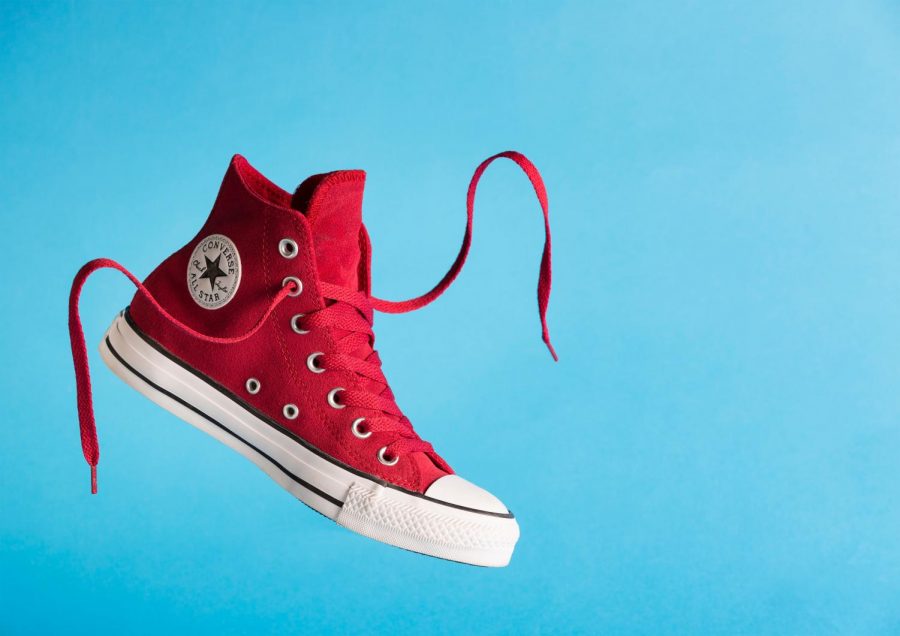The Converse Epidemic
Chuck Out the Old, In With the New
Look down; no really, look down at the floor of Harriton High School. Though you might see the occasional UGG slipper, I have no doubt that the majority of the shoes you see will be those infamous red-and-blue striped shoes. These shoes, as we all know, belong to the revered brand: Converse. For a brand so pervasive, it is only right for me to give you a little backstory. Keep reading to learn more about one of the most popular shoe brands of all time.
The Converse company was created in 1908 as a rain boot company, and it was not until 1917 that Converse made its “all star” debut on athletes’ feet in basketball courts across the country. In 1917, basketball was a fairly new sport, yet its public affection drastically grew. Converse’s reputation followed suit thanks to a man named Chuck Taylor, a young coach who, the world soon learned, was not all that good at coaching basketball. But where Taylor lacked in skill, he certainly made up for in his salesmanship, transforming the company into a household name with an impressive reputation. In fact, Converse sneakers became warmly known by many of their customers as “Chucks.”
Forty years later came another important event in the timeline of Converse; the company broke out of its black-and-white box and released new colors. During the time between their original release and this moment, Chucks had remained the defining shoe for athletes, but unfortunately this did not last long. In the late 60s, Converse began to lose public affection (let’s blame that on Adidas), though they continued to be known as an athletic shoe company, and were even featured in an incredibly popular movie: Rocky (1976). In the late 90s, Converse made their first alteration, which the company soon learned was detrimental to their shoe and their brand image. The idea was to produce a new “All – Stars” shoe, which was intended to focus on comfort and be more consistent with their brand than their previous high top counterparts. However, the public was horrified at the change to the shoe that they had known and loved for so long. Enraged former Converse lovers took to newspapers, namely The Washington Post, to launch their complaints against the “perfect shoe.” Converse quickly switched back to their imperfect shoe, one which has lasted us to the present day.
John O’Neill, head of Converse marketing from 1983 to 1997, told Spin that Converse had always thought of themselves as an “athletic shoe company.” Their basketball branding was still pertinent until at least 2012, when they finally accepted that Converse might have a calling away from basketball. With this in mind, Converse opened “Rubber Tracks,” a studio open to bands for recording. Ever since then, Converse has slightly shifted away from athletics, and given their increased sales, it was a remunerative decision for the company. What was once simply a black-and-white basketball shoe has transformed to include hundreds of designs, patterns, and public interests. Since this switch, Converse has also considerably grown in public support accredited to celebrities including Milly Bobby Brown in Stranger Things, John Travolta in Grease, and more who wear the iconic Chuck Taylor on the big screen.
Converse has even released what they call the “Forever Sneaker,” a timeless shoe fit to serve us through another hundred years. And, given the past history of the brand, I, and many others, have to agree that this future for Converse is plausible.
Although, up until now, this article has been centered around the most well-known Converse high top, it is key to mention there are a variety of Converse styles and colors, all of which have graced Harriton High School. For example, the “Run Star Hike” features a two-tone rubber outsole, which is a few centimeters higher than the high top we all know. There is, of course, the “Platform Converse,” which feature a similar raised platform but contain the traditional white-and-black striped sole that the public loves. As for colors, the common Harriton shoes range from white, black, green, red, blue and the occasional zebra print.
If you have read my previous article, 4 Brands’ Chokehold on Our School, you will understand my opinion on the student body mirroring the fashion choices of one another. While Converse shoes may be worn for numerous reasons aside from the popularity of the shoe, such as the constant comfort, vintage look, and versatility, I encourage you to branch out and try new brands of shoes.
Veja, a French footwear brand, is making strides in terms of designs and colors, along with Koio, an Italian pure leather shoe company. ABLE, a Portuguese shoe brand, features a Napa leather body in various popular styles such as the Blake sneaker, Emmy sneaker, and Nera sneaker. Let’s not forget, these are only a few examples of the many unique alternative shoe options.
While all sneakers have a few things in common, it is important to find the shoe that represents you, resonates with your personality, and most importantly, doesn’t give you blisters! Maybe it’s time to, quite literally, Chuck out the old, and bring in the new. And remember, stay tuned and stay you!

Nora, an IB Senior, is thrilled to take on the role as Features Editor within the Harriton Banner. When not editing, Nora is the President of DECA, an...


